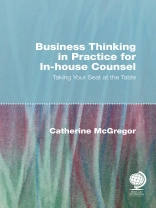Many of the innovations and ideas that legal teams need to embrace – such as those relating to project management and use of technology – have already evolved within the wider business environment. Despite this, many general counsel and other legal leaders report that they feel unprepared to tackle key business challenges and concepts.
Business Thinking in Practice for In-house Counsel: Taking Your Seat at the Table takes a practical look at key concepts from influential business theory and illustrates how these are applicable to managing or working in an in-house legal department.
Topics covered include purpose, culture, talent and innovation, all of which intersect to provide the structure and framework for legal teams to create a competitive edge. Each chapter features an interview and case study with a general counsel and/or legal team to demonstrate how business concepts can be used in-house most effectively.
The author, Catherine Mc Gregor, has engaged with the in-house legal market for many years as a journalist, consultant and commentator. During this time she has built close relationships with leading general counsel around the world and has observed first hand how the role of general counsel has changed and continues to change.
Business Thinking in Practice for In-house Counsel is packed with lots of real-life examples and makes essential reading for any general counsel or senior in-house lawyer seeking to develop their business skills and maximise their team’s success.
Mục lục
Acknowledgements 7
Introduction 11
Part I: Purpose 23
1. Why are we here? Why defining purpose matters 25
2. Bigger than you and me: purpose and values 31
3. Simon Sinek: start with why 37
4. Purpose in practice 45
5. Purpose versus… purpose? The challenge of wearing two hats 55
6. Case study: setting a meaningful and sustainable purpose – The Crown Estate 65
Part II: Culture 83
7. Why culture? 85
8. What creates a good corporate culture? 97
9. A sense of purpose and culture creation 109
10. Case study: the Pearson legal department – from Project Roadmap to Ethos 117
Part III: Leadership 135
11. Leading versus managing 137
12. The need for self- leadership 143
13. Lawyers and leadership 149
14. Servant leadership: lessons from the military 169
15. Leadership case studies 181
Part IV: Talent 201
16. The need for talent 203
17. In-house lawyers and the definition of talent 213
18. Putting talent to work: how lawyers work and how that is changing 221
19. Whose talent is it anyway? Diversifying the workforce 231
20. Futureproofing: redefining talent and redefining expertise 239
21. Future talent: Schlumberger’s marriage of people, process and technology 247
Part V: Creativity
23. Creative cultures: freedom and discipline 269
24. Debunking the myths of creativity – or why anyone can be creative 279
25. Divergent thinking 283
26. A framework for thinking differently: legal design thinking 295
27. Tears in the rain: the lawyer/non-lawyer conundrum 301
28. Case study: playing with your head up – the Royal Bank of Scotland’s outsourcing, technology and IP legal team 305
Part VI: Collaboration 319
29. Working together 321
30. Internal collaboration 331
31. External collaboration 343
Part VII: Innovation 353
32. Innovation: starting with the right question 355
33. Theories of innovation 361
34. Why legal teams need to innovate – and how they can do so 373
35. Innovation strategy 379
36. Case study: DXC Technology – a new blueprint for legal teams 391
Conclusion 405
About the author 411
Index 413
About Globe Law and Business 423












